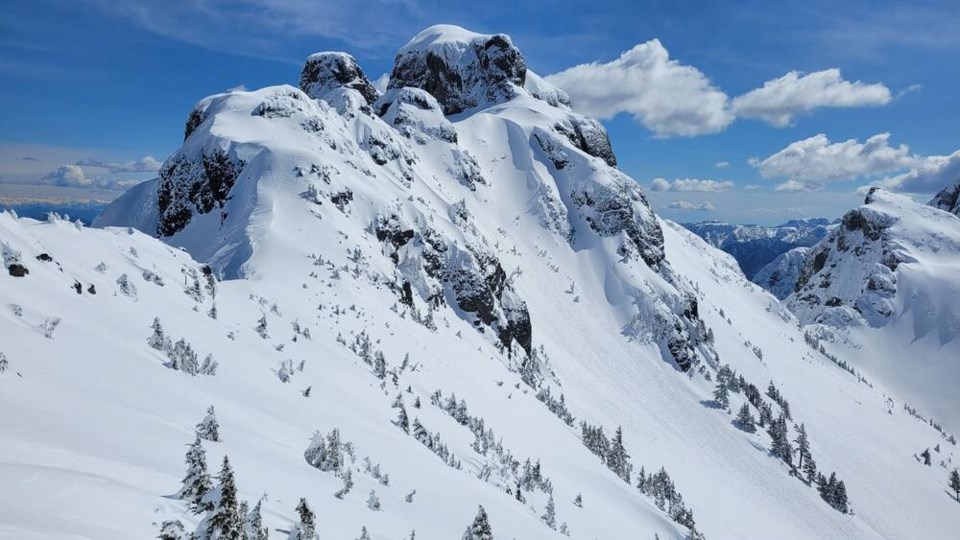While the B.C. Interior is having one of the deadliest avalanche seasons in a decade, the Island’s winter season has been pretty typical, an avalanche forecaster says.
“In general, the Island does beat to a bit of a different drum than does the Interior of British Columbia,” said Colin Garritty, a forecaster and field technician on Avalanche Canada’s Vancouver Island team.
Lower elevations, warmer temperatures, warmer storms and rain bring a coastal snowpack that tends to stabilize more quickly than in the province’s Interior, he said.
The problematic layer in the Interior’s snowpack that has led to 12 deaths this year existed on the Island back in December, but really warm storms and the weight of wet, heavy snowfalls have “basically crushed that layer into oblivion,” Garritty said.
“That snow is still down there at the base of the snowpack, but it’s really packed tight, kind of moist snow. And so it doesn’t behave the same way as it does in the Interior, where it’s been preserved, and actually even worsened over periods of time where we get cold snaps,” he said.
Cold temperatures tend to weaken snowpack, which makes the Island’s relatively warmer winters favourable to less risky avalanche conditions in general.
The Island more commonly has “direct action avalanche problems,” meaning big, powerful storms that dump tons of snow with strong winds that lead to deep slabs forming and lots of avalanches occurring during these times, Garritty said.
“Then in a relatively short period of time — and again this is a tendency — we tend to see those direct action, those surface instabilities settle and bond to the previous surface,” Garritty said.
Between storms, avalanche risk on the Island tends to comes from loose snow kicked up by the wind, which can form surface instabilities called wind slabs that can lead to avalanches, he said. Those instabilities tend to settle relatively quickly here compared to elsewhere in B.C., Garritty said, but he cautioned these are tendencies and not hard rules.
On the north Island, Avalanche Canada has been observing a crust buried about 80 centimetres deep in the snowpack for the last week or so. Field tests were showing the snowpack fracturing at the crust, Garritty said, indicating a good potential for avalanches to happen at the crust.
“It’s something that was sticking around for well beyond the storm cycle,” he said. “So, usually, we would see something like that bond up but it wasn’t happening. And so we always have to be on guard and watchful for those kinds of problems that persist beyond the typical window of instability that we tend to see here.”
One difference on the Island that can make things trickier is that avalanche terrain — a place on a mountain where avalanches can occur under the right circumstances — exists at all elevation bands, dipping into below the treeline, whereas in most areas below treeline in the Interior you can recreate outside of avalanche terrain, Garritty said.
Spring can bring more people into the backcountry because of warmer weather and longer days, but more sun can drive avalanche activity, Garritty said. March is statistically the deadliest month for avalanche accidents in Canada. However, there’s never been a recorded death on the Island from an avalanche.
As of Sunday, the avalanche risk on the Island was rated as considerable in the alpine, meaning human-triggered avalanches are likely and moderate at treeline, where human-triggered avalanches are possible. An update Sunday morning said that overnight snowfall was variable and expected to continue through the day and warned backcountry explorers to watch for reactivity in wind-loaded features.
Comox search and rescue have had a slower than usual winter season, said Troy Fogarty, the volunteer group’s avalanche team lead. The team has not yet been called out to any snow-related incidents, he said, but he cautioned the season is far from over. Last year volunteers rescued a skier who became lost on Mount Becher in June.
Forgarty said he thinks this could be a quieter winter for search and rescue because many who play in the backcountry are getting the essential training they need before heading out, and Avalanche Canada is doing a good job of educating through webinars and public outreach.
Island Alpine Guides, which runs Avalanche Skills Training courses, has seen a huge increase in demand since the pandemic, so much so that the company doubled in size, and that’s continued even as life has returned mostly to normal, said director Jan Neuspiel, a long-time Island guide.
Customers in the courses this season all want to know if the well-known problems in the Interior are also an issue on the Island.
“I’ve heard that question a lot this winter, and mostly the answer has been no,” Neuspiel said.
>>> To comment on this article, write a letter to the editor: [email protected]



